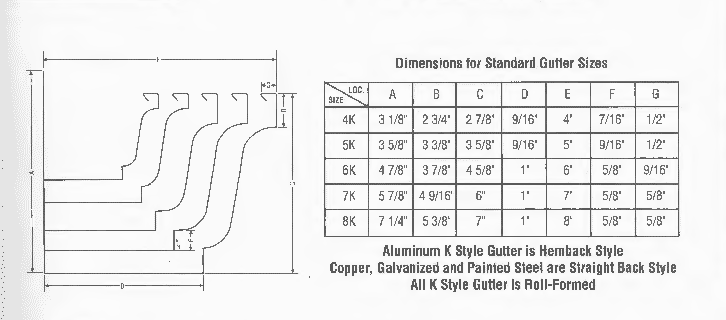|
|
 |
 |
 |
K-Style Gutter Sizing Chart |
|
|
 |
 |
 |
Dimensions for Standard K-Style Gutter Sizes In sizing rain gutters, the following consideration are important. Currently there is no standard in the roof drainage industry but these concepts are based on handed down experience. Outlet Sizing and Spacing Your gutter system will perform its best when a proper outlet size is chosen to drain a given roof area. Downspout sizes must not exceed the bottom width of the gutter. furthermore, the standard norm for gutters among many in the rain carrying industry is to allow 1 square inch of outlet opening in the gutter for every 100 square feet of roof area being drained. Roof Slope Rainwater must not overrun the front edge of the gutter. A steep pitched roof can accelerate rainwater velocity. The gutter must not be hung too high or too low against the fascia or eaves of the roof.Gutter Slope To allow for proper drainage in gutters, allow the gutter to slope approximately 1/4" drop every 10 feet toward the downspout for adequate drainable. To prevent mosquitoes, your gutter system must not hold rainwater.Gutter Style gutters are typically K-Style and Half-Round Styles though custom profile are available. K-Style sizes will typically range from 5" to 6". 7" and greater are appropriate for churches and larger commercial buildings. As a general rule, eGutter™ recommends for roof areas that exceed 2800 square feet, a 6" K Style size with a 3"x 4" downspout size would be appropriate.Metal Corrosion Issues all gutter and components must be the same to prevent electrolysis or electrical corrosion. See 'Galvonic Corrosion' for more detail.Please note that our aluminum K-Style Gutter is Hemback Style. Copper, Galvanized and Painted Steel are Straight Back Style. All K Style Gutter is Roll-Formed.
E = This number identifies the accepted industry size description of the K gutter even though actual K-Style gutter profile sizing may slightly vary depending on who isthe gutter forming machine manufacturer.
|
|
|
|
|